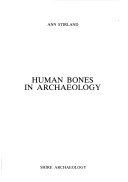Shire Archaeology
1 primary work
Book 46
The human skeleton, often ignored or even discarded by early archaeologists, has become of great interest and importance to their modern counterparts. Known as physical anthropology, the study of skeletons is a vital part of environmental archaeology. Human bones provide accurate evidence for the physical characteristics of a previous community, and are a major source of evidence for diseases that scar bone, such as tuberculosis, leprosy, and syphilis, and their subsequent evolution within populations. Ann Stirland describes human skeletons and their variations as a result of diet, environment, and disease, along iwth the effects on the bones of various burial conditions and rituals. Guidance is offered on methods of excavation, treatment, recording and analysis, and numerous illustrations show the reader what to look for.
